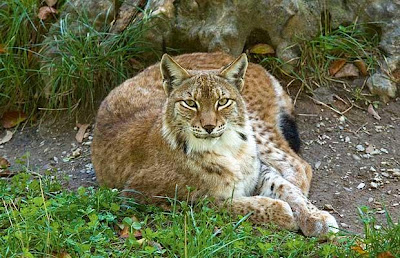The Life of Animals | Eurasian lynx | The Eurasian lynx is the largest lynx species, ranging in length from 80 to 130 cm (31 to 51 in) and standing about 70 cm (28 in) at the shoulder. Males usually weigh from 18 to 30 kg (40 to 66 lb) and Females weigh 10 to 21 kg (22 to 46 lb). Male lynxes from Siberia, where the species Reaches the largest body size, can weigh up to 38 kg (84 lb) or reportedly even 45 kg (99 lb). During the summer, the Eurasian lynx has a Relatively short, reddish or brown coat, the which tends to be more brightly colored in animals living at the southern end of its range.
Some animals also possess dark brown stripes on the forehead and back. Although spots growing niche to be more in animals from southern Numerous Populations, Eurasian lynx with Heavily spotted fur may exist close to others with plain fur Eurasian lynx make a range of vocalizations, but are silent Generally outside of the breeding season. Remnants of prey or tracks on snow are usually observed long before the animal is seen. Lynx prey on Hares, rabbits, rodents, grouse, wild boar, chamois, foxes, roe deer, and reindeer.
In winter snow Certain conditions make this harder and the animal may be forced to switch to larger prey. Eurasian lynx hunt using both vision and hearing, and Often climb high onto rocks or fallen trees to scan the surrounding area. The Eurasian lynx inhabits forested rugged country Providing plenty of hideouts and stalking opportunities. Depending on the locality, this may include Forest-Steppe, boreal forest, and montane forest. In the more mountainous parts of Their range, Eurasian lynx will descend into the lowlands in winter, following Their prey, and avoiding the deepest snows.
in Russian forests, the most Important predators of the Eurasian lynx are the gray wolf and the wolverine Wolves kill and eat lynxes That fail to escape into trees, lynx and wolves when Decrease Populations Appear in a region Wolverines have killed and eaten lynxes and Their stolen kills, and lynxes avoid Encounters with Wolverines. Sometimes, Siberian tigers have also preyed on lynxes, as evidenced by examination of stomach contents Lynx tiger Compete for food with the predators described above, and also with the red fox, eagle owls, wild boar (which scavenge from lynx kills), and in the southern part of its range, the snow leopard and leopard also. The hunting area of the Eurasian lynx can be anything from 20 to 450 km2 (8 to 174 sq mi), depending on the local availability of prey. Males growing niche to hunt over much larger areas than Females, the which growing niche to occupy exclusive, rather than overlapping, hunting ranges. The mating season for Eurasian lynx Lasts from January to April. Unlike the closely related Canada lynx, the Eurasian species does not Appear to be Able to control its reproductive behavior based on prey availability. Because this may be, feeding on a larger range of prey than the Canada lynx, Suitable rarity of prey is a less common occurrence. Pregnant Females construct dens in secluded locations, protected by overhanging branches Often or tree roots. At birth, the Eurasian lynx kittens weigh 240 to 430 grams (8.5 to 15 oz) and are blind and helpless. They initially have plain, greyish-brown fur, attaining the full adult colouration around eleven weeks of age.











